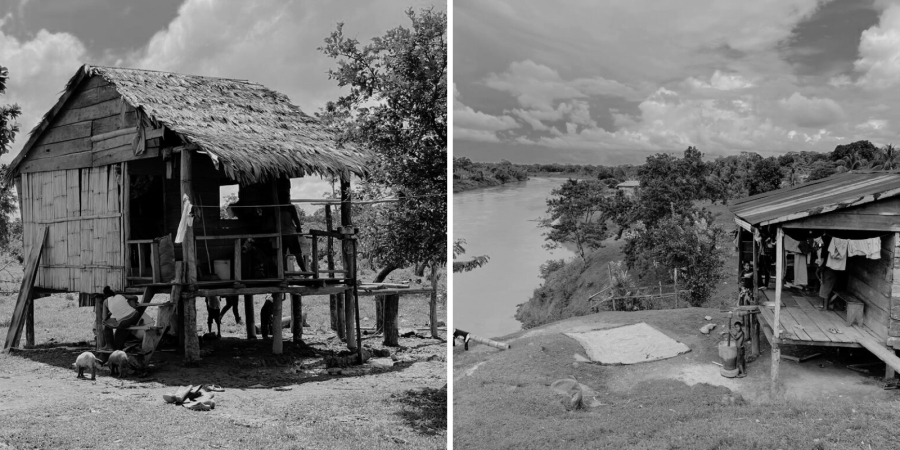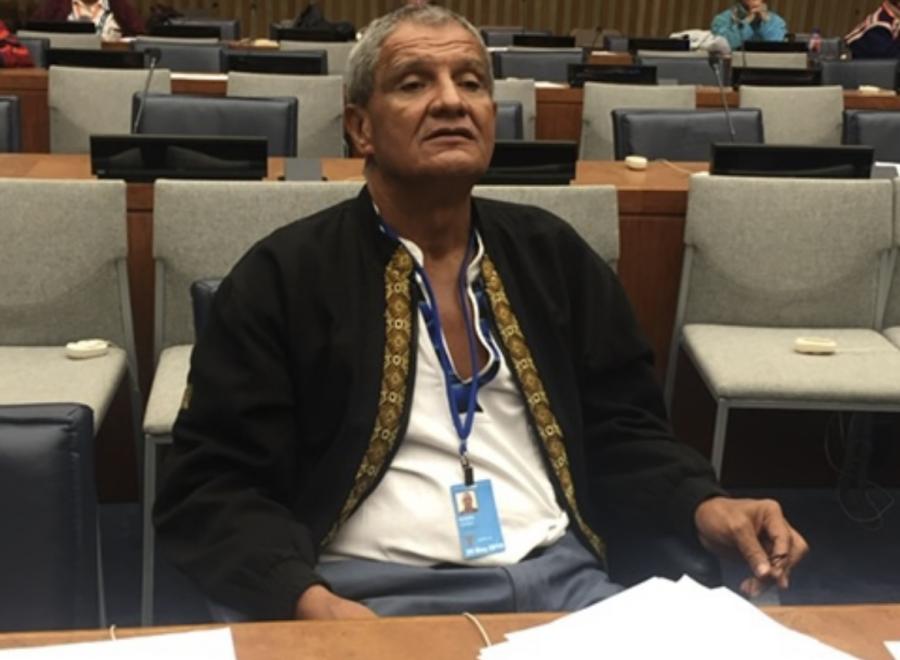The Nicaraguan government and Misurasata, the insurgent national Indian organization, have begun formal negotiations for a treaty to end the fighting which has become endemic on Nicaragua's Atlantic Coast since 1981. The process is slow because the goal is not simply a cease fire but a broad agreement to resolve the fundamental disagreements which produced the conflict. If successful, the talks will lead to a peace with dignity and longevity.
The first steps of the initiative took place when Rivera visited Nicaragua in October 1984. This was followed by an abortive trip to Honduras (November 22-24) where the Misurasata leaders were jailed immediately and deported violently by Honduran authorities. Although the purpose of the trip was to discuss a unification of all Miskito Indians in exile for subsequent peace negotiations in Nicaragua, a move which clearly would decrease border tension, the Honduran government, in a display of spurious logic, stated that the deportation would compromise that country's "neutrality" and, somehow, further strain relations with neighboring Nicaragua.
By contrast, the Colombian government, particularly President Belisario Betancur, has been a strong supporter of the peace initiative. President Betancur invited both parties to meet on a regular basis in Bogotá and, for the first round of negotiations (December 8-9, 1984), provided the presidential palace as a meeting place. The following brief analysis of those meetings, summarized by Dr. Bernard Nitschmann, an advisor for Misurasata, illustrates the sharp differences which each party brings to the negotiating table. This analysis is followed by an unofficial translation of the position paper presented by Misurasata.
Bogotá
The four-member Misurasata delegation was headed by its General Coordinator, Brooklyn Rivera, and the nine-member Nicaraguan Government of National Reconstruction (GRN) delegation was headed by Luis Carrion, Vice Minister of the Interior. Nine international observers and advisors were present as well as representatives of the governments of Canada, Colombia, Holland, Mexico and Sweden.
Primary Objectives
The Sandinistas focused on ending the Indian war and beginning a step-by-step process to provide "special rights" to indigenous peoples and ethnic groups through a government commission, the Comisi Nacional de los Estatutos de la Autonomía. Misurasata, however, stressed an end to "institutionalized repression" and an acceptance of Indian rights and self-determination, to be negotiated through a direct agreement between the Nicaraguan state and indigenous nations. That is, the Indians seek not an accommodation determined by a government commission, but an autonomous status whereby they have recognized rights of self-determination and self-defense within their homelands.
Autonomy
Perhaps no single concept or stance has kept the two positions apart more than that of autonomy. The Nicaraguan government appears to interpret the Indians' demand for autonomy as constituting the makings of a separate state. Misurasata, however, presented autonomy as local rule by local people over local affairs. If indigenous rights to self-determination become part of a peace treaty, both parties must then determine how that will be carried out; in other words, what autonomous functions will local self-determination encompass? The GRN proposes to study and recommend the limits to autonomy through a government commission. Misurasata suggests instead that the content and context of autonomy be established through direct discussions between Indian and government leaders, or by the Indian people themselves in an Indian Congress or general assembly meeting. Their point is that it is contradictory for the government to unilaterally establish the conditions for indigenous self-determination.
The government maintained that they were unclear about what was meant by autonomy. In return Misurasata claimed that the GRN does not want to understand because autonomy threatens the central government by decentralizing control. For Misurasata, autonomy means 1) the recognition of indigenous communal ownership of village communal lands, waters and resources that collectively comprise Miskito, Sumo and Rama territories; and 2) the recognition of indigenous rights of self-determination such that Indian peoples (and ethnic groups) may pursue their distinct and independent political, legal, and economic and religious institutions.
Many indigenous peoples and ethnic groups have institutionalized political and economic autonomy from the central government; for example, the San Bias Kuna (Panama), the Naga (India), the Inuit (Greenland), the Basques (Spain) and many other groups.
Indigenous Peoples and Ethnic Groups
Considerable attention was devoted to discussion of terms of identity. The GRN delegation at first argued that the Miskito, Sumo and Rama should be considered ethnic groups; that is, special minorities within the overall context of one state and the Nicaraguan people. The GRN's reluctance to recognize the identity of Indians as "indigenous peoples" and "nations" may stem from the government's knowledge that various international laws, declarations and covenants proclaim indigenous peoples' rights to self-determination.
Misurasata's response was that the Miskito, Sumo and Rama recognize themselves as distinct peoples, and that Indian people do not need the recognition of the GRN or any western term or institution to define their existence. The people exist as a people: with a collective distinct identity, a shared land base, and a political consensus. The Indians are distinct peoples with historical and aboriginal rights over their territories and resources. They do not accept an identity which has been redefined by the state in order to limit indigenous demands for self-determination as distinct peoples. Rather than argue legitimacy of their identity, or that of Misurasata or the GRN, each group accepted the identity of the other and then proceeded to negotiate a settlement through dialogue and compromise. Agreement was reached that the Miskito, Sumo and Rama would be considered indigenous peoples, and that the Creoles, Garífunsle and Ladino populations on the east coast would be referred to as ethnic groups.
Summary
The central conflict concerns the nature and extent of government or indigenous control of land, waters, resources and peoples; but because of the war, neither side has effective access to the resource base. If the war continues, it is unlikely that this situation will change.
Without a settlement, the FSLN will have to shoulder the economic and human costs of trying to maintain control over the coast and its peoples through military strength and the creation of an allegiance through economic dependence. This will be untenable economically and politically over the long run.
3. Indigenous self-determination simply means decentralization. Indian control over Indian affairs, lands and resources would not in itself threaten or weaken the central government. If anything, it would strengthen the central government politically, economically and militarily. Presently, oppression of Indian peoples is a political embarrassment for the Sandinistas, and the economic and military costs to maintain a degree of control are very high.
4. Rather than defending its actions in the name of national defense, the GRN could remove its military forces from Indian lands, end institutionalized repression, and agree to a treaty with indigenous armed forces that would defend and rationally develop eastern Nicaragua.
With the security of indigenous land ownership and use, the people gain something they won't want to give up to any other interest or force. Indigenous land rights are not part of the goals of the FDN, ARDE, the CIA, or the U.S. State Department. The security of Nicaragua would be strengthened, not weakened, by establishing the security of Indian rights and communal land ownership.
5. The real issue is not whether or not to negotiate a peace treaty, or to decide how much to demand or how much to compromise - a 19th century approach to Indian wars - but to establish a truly revolutionary accord based on the fact that Latin America is also Indian America, and that neither of these two sectors need by remade in the image of the other in order to achieve liberation, progress, justice, or allegiance.
The FSLN represents a revolutionary Third World movement and Misurasata represents a revolutionary Fourth World movement. If the FSLN and Misurasata could reach a treaty settlement that supports the separate but complementary aspirations of Indian and Latin Nicaragua, then the rest of the hemisphere would have a model that exists by example, not one that hides behind pretexts.
Misurasata Proposal Submitted at Bogotá 12/8/84
Initial document of Misurasata for the process of negotiations toward a treaty of peace and recognition of an indigenous territory and autonomy, between the native peoples Miskitos. Sumos and Ramas and the Nicaraguan state.
Bogotá Accord
A cease fire accord, for a period of three (3) consecutive months in the Atlantic region, between the military forces of the government of the Republic of Nicaragua (GRN) and the organization Miskito, Sumo. Rama, Sandinista Aslatakanka (MISURASATA) as of January 15, 1985, a period which shall be extendable in accordance with the progress of the negotiation of a peaceful solution of the present conflict, will take place if the following conditions are met:
I. Official recognition of the ethnic identity and aboriginal rights of the indigenous and Creole peoples of the region.
1.1 The GRN recognizes the Miskito, Sumo and Rama populations as indigenous sovereign peoples of the Atlantic region of the country, each with their own ethnic identity and possessed of the natural right to freely determine their own political, economic, social and cultural development in accordance with their values and traditions.
1.2 The GRN recognizes the inalienable right to an indigenous territory (land, river, lagoon, and sea), with its natural resources. For the Miskito, Sumo, Rama and Creole peoples; the area of this territory shall be delimited in the region during the continuation of the negotiation process between both parties, within the framework of the sovereignty of the Nicaraguan state and the territorial integrity of the country.
1.3 The GRN guarantees the right to an indigenous autonomy for the native nations and peoples of the Atlantic coast within the framework of the GRN; this autonomy shall be concretely defined during the negotiations between both parties and will address the following:
a. Regional government and home rule,
b. Territory and land tenure,
c. Defense,
d. Laws,
e. Organization,
f. Representation in the Nicaraguan Parliament,
g. Relations between the GRN and the indigenous regional government,
h. Mutual cooperation,
i. Regional patrimony,
Article copyright Cultural Survival, Inc.



